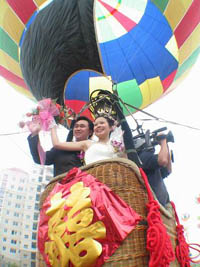China traces its history back some 5,000 years, and some
traditions still maintained today have been around nearly that
long. But a lot has changed as well -- socially, economically and
philosophically -- and the evolution of wedding ceremonies during
the past half-century embodies many of those changes.
1940s: cadres make the day. In the 1940s,
ranking cadres were much sought after to act as chief witnesses at
weddings. The big event lasted just one or two hours, with the
chief witness making a speech and the guests being served sweets
and tea in the assembly hall. There were no formal banquets.
1950s: frugal weddings. People were poor in the
1950s and wedding ceremonies considered bourgeois luxuries. Most
new couples just invited some relatives and friends to have dinner
together and chat for a while.
1960s: photo keepsakes. In the 1960s, couples
began to take wedding photos to commemorate the beginning of
married life. But unlike the glamour shots taken nowadays, couples
donned their best "Mao suits" and sat stiffly together before the
camera. Receptions for most couples involved simply handing out
some candies, peanuts and melons seeds to relatives and friends.
Only high-ranking cadres could order a few special dishes in the
community canteen and perhaps serve some dumplings.
1970s: riding in style. In the 1970s, tricycle
carts were the coveted "limousines" of newlyweds. Lucky bridegrooms
pedaled the tricycle while the beaming bride rode in the back to
their bridal chambers. New couples who couldn't afford even a
bicycle walked to their new home.
1980s: three revolving machines and a sound. In
the 1980s China embarked on its program of opening and reform, and
people had more money to spend on weddings. There were sayings
describing the basic material conditions for getting married:
"three revolving machines and a sound," meaning a sewing machine, a
bicycle, a watch and a radio; and "48 legs," which indicated the
amount of furniture the newlyweds should own, including a cabinet,
a table, chairs and a bed.
In the late 1980s, people began holding formal wedding
receptions. They would select the most voluble of their relatives
and friends to serve as emcee, an important position that became a
symbol of the weddings of that time.
1990s: conspicuous consumption. As people
became increasingly affluent, lavish weddings became a way to show
off wealth. Professionally managed ceremonies and receptions at
special wedding restaurants became popular, often raising the
quality and efficiency as well as the cost of tying the knot.
 2000s: a
matter of personal taste.
2000s: a
matter of personal taste. Today's young couples want
meaning and personal expression in their weddings instead of
reckless extravagance. Many simply pick up their marriage licenses
and then inform their relatives and friends, feeling that it is
more important to spend the money and time on other pursuits.
The Internet has also had an impact. While the newlyweds
themselves still tend to prefer real-time togetherness, they may
just upload photos, videos and other information about their
marriage to a website and invite relatives and friends to view the
page.
For those who still want to make the day particularly memorable,
many are opting for outdoor weddings. The less daring may stick to
a relatively simple villa or lawn wedding, but dedicated divers may
opt for an underwater ceremony while aerial adventurers get hitched
in a hot-air balloon.
(China.org.cn by Chen Lin, March 17, 2005)